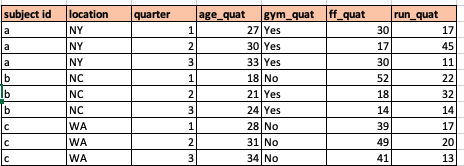I have a dataframe - "exercise" converted into a long format "exerciselong". The data is in individual/month and now I want to convert it into individual/quarter.
Each subjectid has data for 9 months and now I need to convert it into data for 3 quarter by picking data from 3 month for each quarter. 1st quarter - month1-3, 2nd quarter - month4-6 and 3rd quarter - month7-9
Quick variable summary
"subjectid": individual ID
location: location of the subjectid
month_number : 1-9 for each subjectid, starts at 1 for each
age : age of subjectid
gym : 0 = went to gym, 1 = did not go to gym
ff: no of times subjectid ate fastfood each month
run : no of miles subjectid ran each month
exercise <- data.frame(
subjectid = c("a","b","c","d","e","f","g","h","i","j","k"),
location = c("NY","NC","WA","WA","OR","CA","AR","KS","AZ","VT","MA"),
age1 = c(27,18,28,14,11,32,20,19,12,23,34),
age2 = c(28,19,29,15,12,33,21,20,13,24,35),
age3 = c(29,20,30,16,13,34,22,21,14,25,36),
age4 = c(30,21,31,17,14,35,23,22,15,26,37),
age5 = c(31,22,32,18,15,36,24,23,16,27,38),
age6 = c(32,23,33,19,16,37,25,24,17,28,39),
age7 = c(33,24,34,20,17,38,26,25,18,29,40),
age8 = c(34,25,35,21,18,39,27,26,19,30,41),
age9 = c(35,26,36,22,19,40,28,27,20,31,42),
gym1 = c(1,0,0,1,0,0,0,1,0,0,0),
gym2 = c(1,0,0,1,0,0,0,1,0,0,0),
gym3 = c(1,1,0,1,0,0,1,1,1,0,0),
gym4 = c(1,1,0,1,0,0,1,1,1,1,1),
gym5 = c(0,1,0,1,0,0,0,1,1,1,1),
gym6 = c(1,1,0,1,0,0,1,1,0,1,0),
gym7 = c(1,1,0,0,1,0,1,0,0,1,1),
gym8 = c(1,1,0,0,1,0,1,0,0,1,1),
gym9 = c(1,1,0,0,1,0,1,0,0,1,1),
ff1 = c(11,18,16,10,20,12,5,9,0,8,3),
ff2 = c(16,14,17,7,3,0,1,4,8,5,12),
ff3 = c(3,20,6,0,9,16,10,17,19,9,13),
ff4 = c(5,3,15,0,3,16,6,8,10,7,17),
ff5 = c(8,7,20,0,2,3,17,0,1,16,15),
ff6 = c(4,8,14,0,1,20,5,0,6,10,9),
ff7 = c(2,4,7,11,11,10,15,6,20,13,16),
ff8 = c(16,9,12,3,41,19,15,12,6,20,11),
ff9 = c(12,1,22,17,18,13,2,5,3,19,7),
run1 = c(17,16,16,0,20,12,58,89,9,12,15),
run2 = c(3,14,17,7,30,0,1,48,45,50,11),
run3 = c(12,22,6,0,17,16,10,17,19,69,67),
run4 = c(34,32,15,19,9,16,6,8,10,7,16),
run5 = c(45,17,20,10,21,38,017,0,1,16,34),
run6 = c(1,2,14,7,17,2,57,0,6,10,15),
run7 = c(0,14,7,19,11,101,15,6,20,13,17),
run8 = c(9,9,13,3,4,23,11,12,6,20,12),
run9 = c(11,12,11,17,19,15,2,5,3,19,72)
)
library(tidyr)
exerciselong <- pivot_longer(data = exercise,cols = age1:run9,
names_pattern = "([^\\d]+)(\\d+)",
names_to = c(".value","month_number"))
To convert it into person/quarter from person/month, I am trying to use the following conversion strategy
age = age of the first month of the quarter. e.g for subjectid "a" for quarter 1 = 27, quarter 2 = 30 and quarter 3 = 32 (I know this does not make sense but this is just an example data)
gym = If subjectid went at least twice, then gym/quarter = yes(or 1), if <2 : gym/quarter = no(or 0)
ff = sum of ff each quarter, e.g. for a ff for quarter 1 = 11+16+3 = 30, quarter 2 = 5+8+4 = 17, quarter 3 = 2 + 16+12 = 30
run = highest value (mode) of each quarter. e.g. for subjectid "a", quarter 1 = 17, quarter 2 = 45 and quarter 3 = 11
This is how I want my final data to look

Thank you for the help !